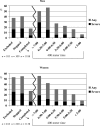Mobility limitation in self-described well-functioning older adults: importance of endurance walk testing
- PMID: 18772472
- PMCID: PMC5722013
- DOI: 10.1093/gerona/63.8.841
Mobility limitation in self-described well-functioning older adults: importance of endurance walk testing
Abstract
Background: Mobility limitations are prevalent, potentially reversible precursors to mobility loss that may go undetected in older adults. This study evaluates standardized administration of an endurance walk test for identifying unrecognized and impending mobility limitation in community elders.
Methods: Men and women (1480 and 1576, respectively) aged 70-79 years with no reported mobility limitation participating in the Health, Aging and Body Composition study were administered the Long Distance Corridor Walk. Walk performance was examined to determine unrecognized mobility deficits at baseline and predict new self-recognition of mobility limitation within 2 years.
Results: On testing, 23% and 36% of men and women evidenced mobility deficits defined as a contraindication to exertion, meeting stopping criteria or exceeding 7 minutes to walk 400 m. Unrecognized deficits increased with age and were more prevalent in blacks, smokers, obese individuals, and infrequent walkers. Within 2 years, 21% and 34% of men and women developed newly recognized mobility limitation; those with baseline unrecognized deficits had higher rates, 40% and 54% (p <.001), respectively. For each additional 30 seconds over 5 minutes needed to walk 400 m, likelihood of newly recognized mobility limitation increased by 65% and 37% in men and women independent of age, race, obesity, smoking status, habitual walking, reported walking ease, and usual gait speed.
Conclusions: A sizable proportion of elders who report no walking difficulty have observable deficits in walking performance that precede and predict their recognition of mobility limitation. Endurance walk testing can help identify these deficits and provide the basis for treatment to delay progression of mobility loss.
Figures

References
-
- Verbrugge LM, Jette AM. The disablement process. Soc Sci Med. 1994;38:1–14. - PubMed
-
- Wolinsky FD, Miller DK, Andresen EM, Malmstrom TK, Miller JP. Further evidence for the importance of subclinical functional limitation and subclinical disability assessment in gerontology and geriatrics. J Gerontol B Psychol Sci Soc Sci. 2005;60:146–151. - PubMed
-
- Shumway-Cook A, Ciol MA, Yorkston KM, Hoffman JM, Chan L. Mobility limitations in the Medicare population: prevalence and sociodemographic and clinical correlates. J Am Geriatr Soc. 2005;53:1217–1221. - PubMed
-
- National Center for Health Statistics, Data Warehouse on Trends in Health and Aging., Available at: http://www.cdc.gov/nchs/agingact.htm. Last accessed June, 2006.
-
- Cavazzini C, Conti M, Bandinelli S, et al. Screening for poor performance of lower extremity in primary care: the Camucia Project. Aging Clin Exp Res. 2004;16:331–336. - PubMed
Publication types
MeSH terms
Grants and funding
LinkOut - more resources
Full Text Sources
Medical

